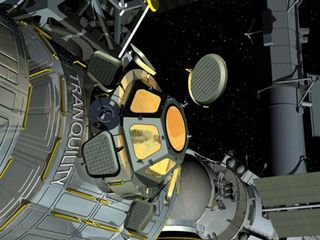World's Largest Space Window Headed to Orbit

Talk about a roomwith a view.The largest space window ever built will launch aboard NASA's shuttleEndeavour onSunday, part of a new seven-portal observation deckfor the International Space Station.
Thenew addition,called the Cupola, will offer astronauts a panoramic view of space and Earthbelow them.
"Cupolais going to be probably the best set of windows that?s ever flown in space onany program in the history of spaceflight," said mission specialistNicholas Patrick, one of sixastronauts deliveringthe Cupola tothe station on Endeavour.
Theshuttle?s STS-130flight, commanded by veteran spaceflyer George Zamka, is scheduled to blastoff at 4:39 a.m. EST (0939 GMT) from NASA's Kennedy Space Center in CapeCanaveral, Fla.
The1.6 ton Cupola stretches 9.7 feet (3 meters) wide, and is nearly 5 feet (1.5meters) long. Its circular top window is 31.5 inches (80 cm) in diameter,making it the largest window ever flown in space.
Thestructure is set to be installed underneath the new Tranquility module, a soda-canshaped room also set to fly aboard Endeavour. The Cupola cost an estimated 20million Euros, or $27.2 million.
"Wewill have the most spectacular view of the Earth anyone?s ever had from theinside," mission specialist Stephen Robinson said in a NASA interview.
Get the Space.com Newsletter
Breaking space news, the latest updates on rocket launches, skywatching events and more!
A room with a view
Thedome's purpose isn't just to provide a great vista, though. It will offer aview of incoming spacecraft to the space station to help with docking andrendezvous, and astronauts can look out the windows when controlling thestation's robotic arm.
"We?llbe able to move the robotic arm control station into that Cupola area, considerit like a bay window, and be able to have an actual out-the-window view tooperate the robotic arm," said mission specialist Kathryn Hire. "Aswe operate today on the InternationalSpace Station for the robotic arm, we?re using all external camera views.We have no direct window views to operate the arm."
Theseven windows have been specially outfitted with shell-like aluminumshields that can be closed over them when they are not in use to protect theglass from damage by tiny meteoroids and orbital debris.
Evenwhen the shutters are open, the windows will have a measure of protection froman external pane of glass specially designed to act as a barrier againstdebris. If a window is damaged by space junk, it can be replaced in orbit. It?s a difficultrepair, but not impossible, mission managers said.
TheCupola's windows are not science-grade, however ? their clarity is not of quiteas high quality as the windows in the station's Destiny module, for example, somany of the Earth observation science photos will still be taken from thatroom.
Window on the world
Thedome's role as a relaxing hangout is an important aspect of its design, too.
"Crewstell us that Earth gazing is important to them," said Julie Robinson,space station program scientist at NASA's Johnson Space Center in Houston."The astronauts work hard up there and are away from their families for along time. Observing the Earth and the stars helps relax and inspirethem."
Thoughthey will be part of the U.S. segment of the space station, the Cupola and thenew Tranquilitymodule were both built by the European Space Agency as a contribution inpayment for America's role transporting European astronauts to and from thestation on space shuttles.
"Itis our great privilege to bring up Node 3 and the Cupola, and these are thelast U.S. major components that are coming up to the International SpaceStation," Hire said.
- NASA's Final Night Shuttle Launch Visible From Eastern U.S.
- Video - Behind the Scenes of Endeavour's STS-130 Mission
- Images - Space Shuttle's Midnight Launch
SPACE.comis providing complete coverage of Endeavour's STS-130 mission to theInternational Space Station with Managing Editor Tariq Malik in Cape Canaveral andStaff Writer Clara Moskowitz in New York. Click here for shuttlemission updates and a link to NASA TV. Live coverage begins at 11:30 p.m. ET.
Join our Space Forums to keep talking space on the latest missions, night sky and more! And if you have a news tip, correction or comment, let us know at: community@space.com.

Clara Moskowitz is a science and space writer who joined the Space.com team in 2008 and served as Assistant Managing Editor from 2011 to 2013. Clara has a bachelor's degree in astronomy and physics from Wesleyan University, and a graduate certificate in science writing from the University of California, Santa Cruz. She covers everything from astronomy to human spaceflight and once aced a NASTAR suborbital spaceflight training program for space missions. Clara is currently Associate Editor of Scientific American. To see her latest project is, follow Clara on Twitter.
